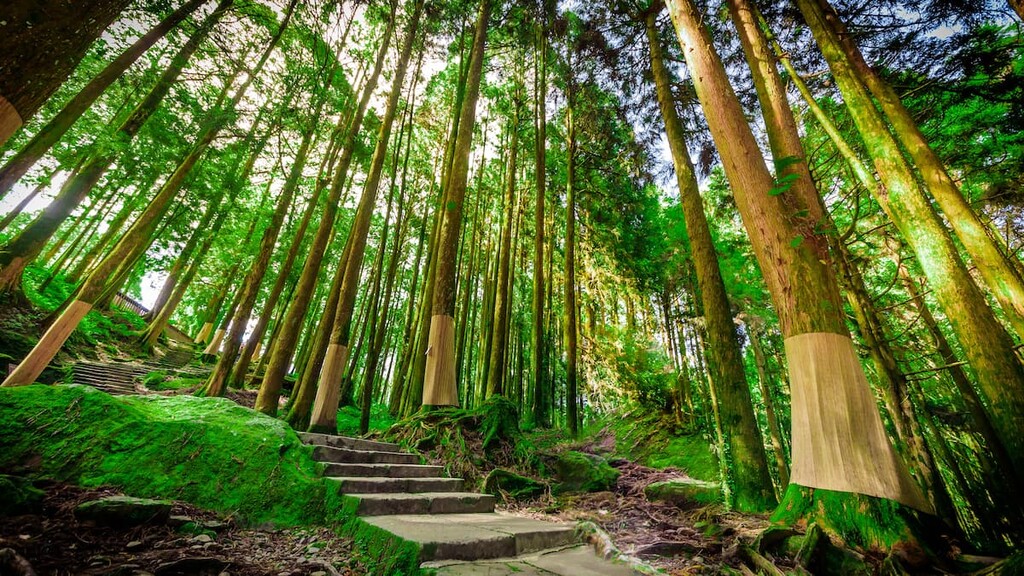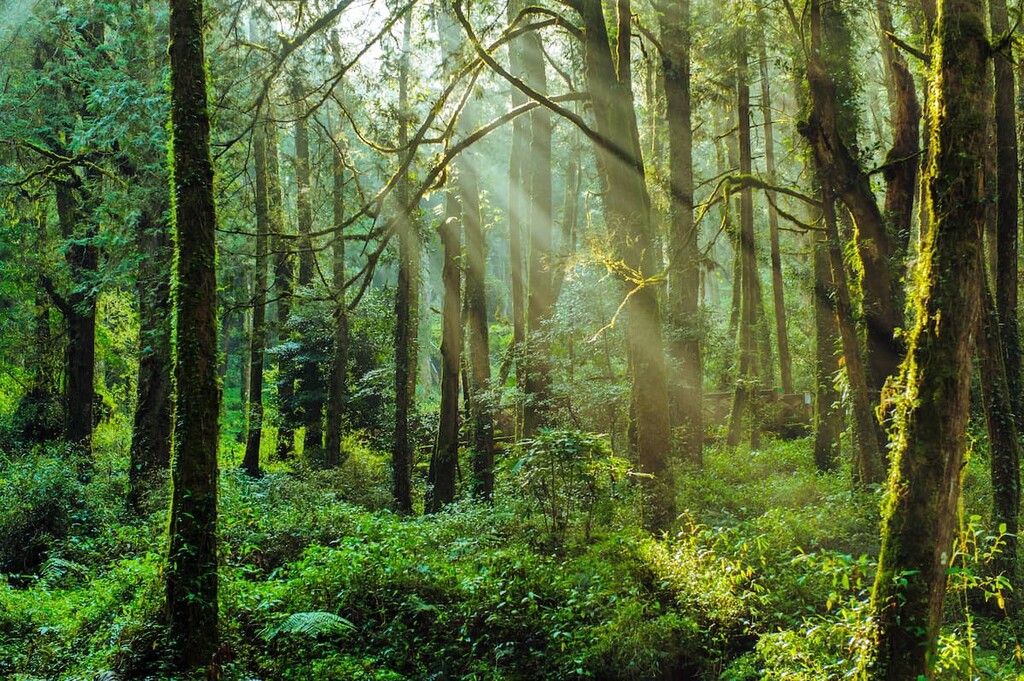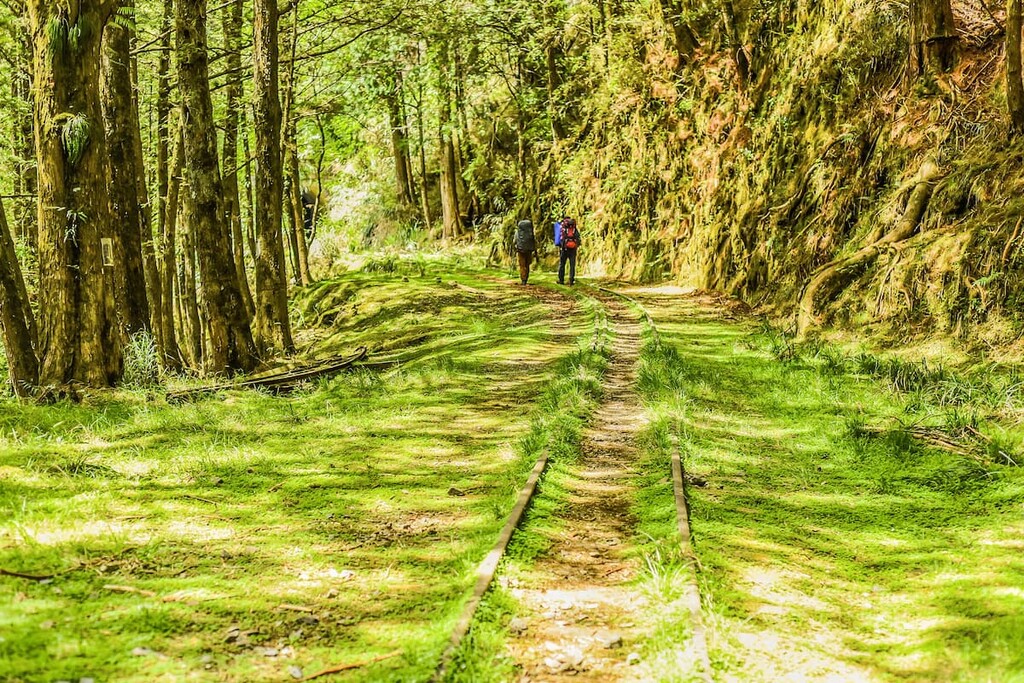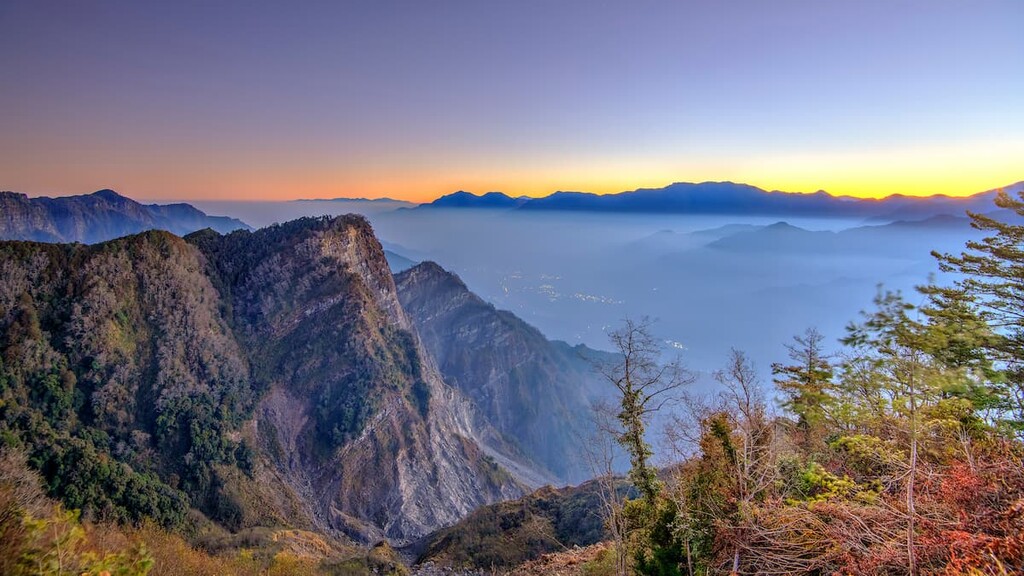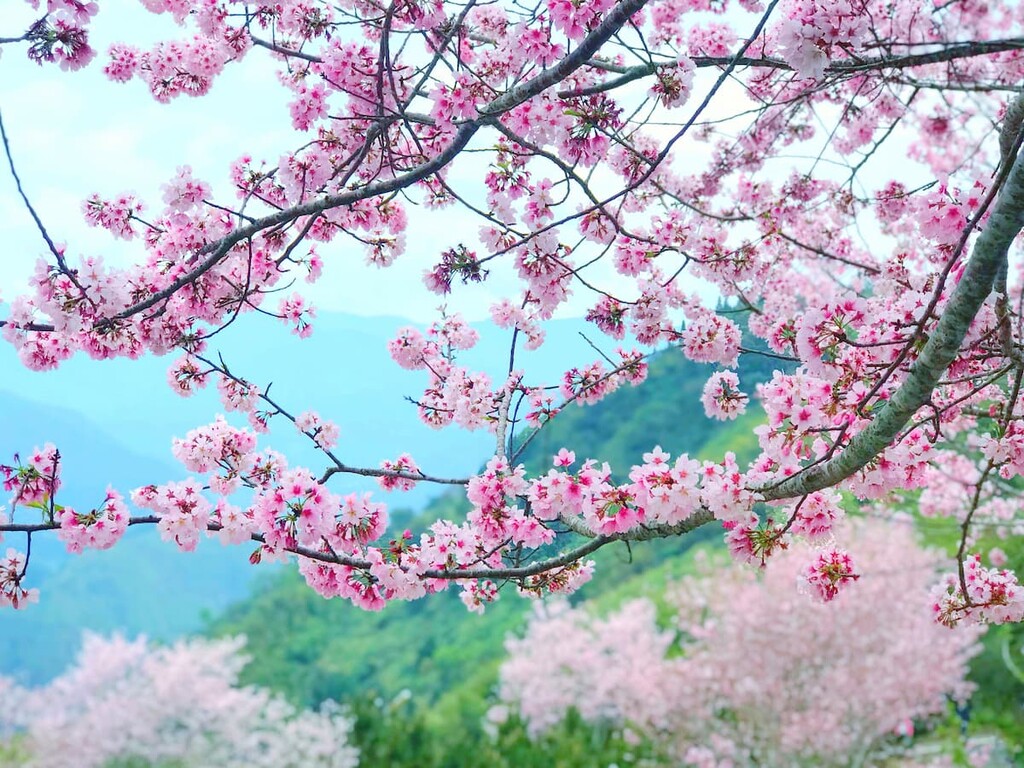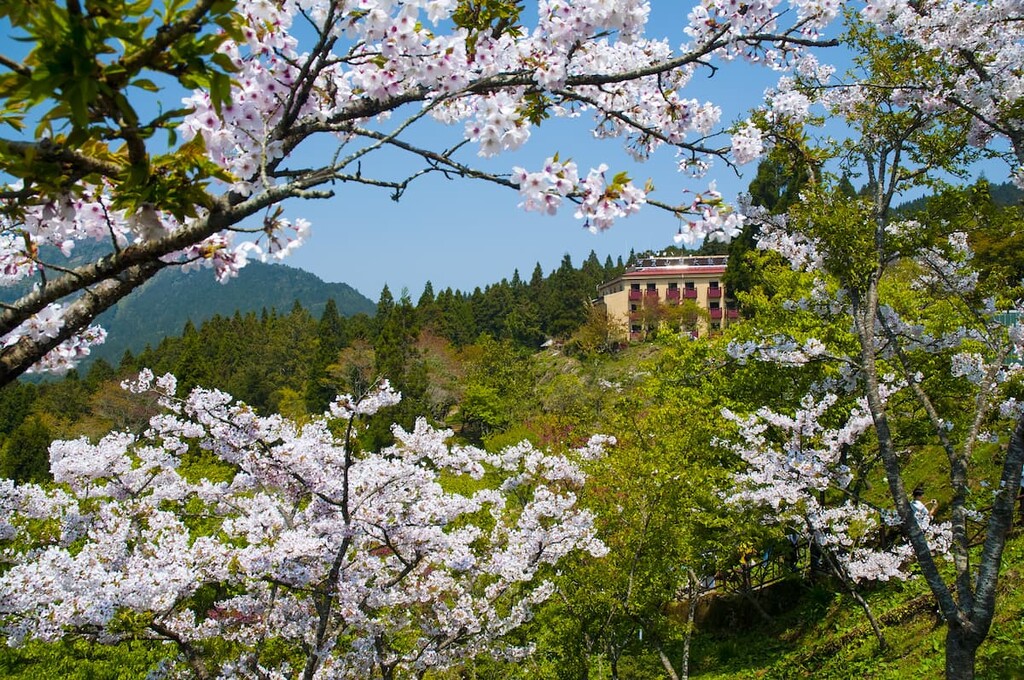Get PeakVisor App
Sign In
Search by GPS coordinates
- Latitude
- ° ' ''
- Longitude
- ° ' ''
- Units of Length
Share×

Scan the QR code and open PeakVisor on your phone
❤ Wishlist ×
Choose
Delete
One of the premier spots for anyone looking to experience Taiwan's most popular and naturally breath-taking scenery, Alishan National Forest Recreation Area (阿里山國家森林遊樂區) is a popular outdoor recreation area on the island. It is best known for its radiant sunrises amidst a sea of clouds, the dusting of pale pink cherry blossoms in spring, a Forest Railway winding its course through verdant misty mountain forests with millennia old trees towering over the mossy forest floor.
Alishan National Forest Recreation Area consists of 25 mountains over 2,000 meters (6,562 ft) with the highest mountain being Da Ta Shan (大塔山) standing at a prominent 2,663 metres (8,737 ft).

Alishan National Forest Recreation Area covers an area of 14 sq km (5.4 sq mi) and is situated in Alishan Township of Chiayi County (嘉義縣), remarkably close to Nantou County (南投縣), placing it in the very centre of Taiwan. Alishan National Scenic Area (阿里山國家風景區) encompasses the main region of Alishan; however, the quaint ethereal beauty of the forest and the famous sighting of cherry blossoms accentuate the world renowned Alishan National Forest Recreation Area.
The five wonders of the Alishan National Recreation Area that attract tourists to this enchanting scenic area are the gentle sunrises, fluffy sea of clouds, glorious sunsets, deep forests, and the historically iconic Alishan Forest Railway.
Yushan National Park (玉山國家公園)is just a stone throw away to the east in Nantou County, with the calming Dongpu Hot Springs (東埔溫泉) sitting northeast of Alishan. Fenghuanggu Bird Ecological Park (國立自然科學博物館鳳凰谷鳥園生態園區) lies to the north, while Danaiku Nature Ecological Park (達娜伊谷自然生態公園) is situated to the southwest of Alishan.
While Alishan National Recreation Area does not contain any of Taiwan's Top 100 Mountains, it is the captivatingly beautiful scenery of this area that attracts tourists to visit its dreamy alpine forests.
Besides the highest peak of Da Ta Shan, other notable mountains in the Alishan National Forest Recreation Area are Zhushan (祝山), Xiao Li Yuan Shan (小笠原山), Ta Shan (塔山), Wansui Shan (萬歲山), Dui Gao Yue Shan (對高岳山), and Xiao Ta Shan (小塔山).

Due to the high mountain elevation of the region, the park has a moderate climate with an annual temperature of 51°F (10.6°C) that contributes to the foggy and rainy weather found in the area. With an average rainfall of up to 4,000 mm (157 in), the forest is brimming with life and is dense in foliage.
Alishan is not a name of a single mountain; rather, it is the name of an entire mountain area in the rugged region of central Taiwan. The mountains of the Alishan National Forest Recreation Area rest along the Alishan Mountain Range (阿里山山脈), which branches off from the Yushan Range (玉山山脈). Together, these two ranges are among the largest mountain ranges in Taiwan.
The mountains of the Alishan Range were borne as a result of the force of the Philippine Sea plate and Eurasian plate pushing towards each other, creating a high landmass in the form of steep mountains. It is believed that mountains on the east coast were formed progressively from east to west due to the south-eastern tectonic activity, thus the Central Mountain Range (中央山脈) was formed first, followed by Xueshan Range (雪山山脈), Yushan Range, and finally Alishan Range.

Alishan was still a body of water welling in gravel and sand from neighbouring regions when the previous mountain ranges were formed, thus the strata of Alishan are relatively young in comparison. The exposed rock on Alishan is different from that of nearby Yushan, as Alishan is composed mainly of sedimentary rock while Yushan has undergone a metamorphosis.
Sedimentary rock is formed from the process of the compression of underwater rock or minerals creating a bonding between these materials. The sedimentary rock composing Alishan is mainly sandstone, shale, and conglomerate rock.
As Alishan slowly formed from the sea, the strata underwent erosion, collapse, and weathering, thus the collection of lower strata can be noted on the surface of the rock. The exposed strata of Alishan are sedimentary rock between the late Tertiary and Miocene periods to the Pleistocene period (about 11.6 million to 2.6 million years ago).
Alishan National Recreation Area is a beloved place to witness the sprouting of cherry blossoms between March and April, and the lilac bursts of blooming wisteria shortly afterward.
The forest is home to four different species of cherry blossoms: Fuji, Yoshino, Taiwan, and Yaezakura, gracefully bursting with spring colours of soft white to bold pink.

Rich forest resources distinguish Alishan National Forest Recreation Area as it includes a variety of plants from different climatic zones along the differing levels of altitude. Tropical trees such as acacia, betel nuts, Machino bamboo and longan are found on the lower levels of the mountain, while warm temperate trees like the moso bamboo, jelly fig, and high-mountain tea grow in higher regions as the altitude increases.
Further up the mountain lies the temperate trees of Japanese cedar, Taiwan red cypress, Taiwania, and Taiwan yellow cypress. The vegetation of the lush alpine forest is mostly characterised by the conifer species, such as Yushan spruce, Chinese hemlock (abies kawakamii), which only grows in Taiwan, and the Alishan elm, which can only be found in soils of the Alishan Region.
The forest had an abundant population of Taiwan red cypress and yellow cypress trees, however, due to the extreme felling of trees during the Japanese Occupation Era, there are only 41 millennia-old cypress trees that still exist along the path of the Giant Tree Trail in the recreation area.
The Alishan Xianglin Sacred Tree towers as Alishan's tallest tree standing at 45 metres (148 ft) in height and with a great circumference of 123 metres (404 ft). This tall tree is believed to be approximately 2,300 years old.
The forest also holds a variety of rare plant species such as the Oleandra wallichii, Huperzia somae, Alishan mahonia, and Taiwan pleione.
Mammal species inhabiting the alpine forest are the Formosan rock macaque, Palla's squirrel, Owston's long-nosed tree squirrel, and Reeve's muntjac.
Alishan is a well-known bird-watching haven as the singing birds circulate in the cloudy skies above the towering alpine trees. Middle and high-altitude birds such as the grey treepie, Mikhado's pheasant, Taiwan bar wings, Taiwan whistling thrush, and the collared bush robin can be spotted in the Alishan area.

The area of Alishan was first settled by the Tsou tribe, however, the emergence of ethnic Han Chinese settlers in the mid-seventeenth century along the plains near Chiayi City disturbed the indigenous Tsou tribe.
Armed clashes between the Tsou people and Han settlers resulted in the Tsou people fleeing further into the mountains. The mountain villages of Ruili, Ruifeng, Xiding, and Fenqihu were established in the late eighteenth century by the Han settlers as an attempt to gain control of the Alishan area.
During the Japanese Occupation Era, Japanese excursions into the forested area of Alishan discovered a large quantity of cypress trees which resulted in logging to export the local cypress wood. To achieve this, a railway was built to transport the wood from the mountains to the coastal plains where they would be shipped. This then led to the development of several new villages along the route of the railway.
With the alarming low supply of cypress in the 1970s, domestic and international tourism overtook the logging industry to become the primary economic activity, and to combat overcrowding from the booming tourist industry, the forest was declared a national scenic area in 2001. Thus, Alishan National Scenic Area was established, preserving the wooded mountainous region of the Alishan National Forest Recreation Area.

Besides the five wonders of the Alishan National Forest Recreation Area, there are numerous options at hand to discover one of the most delightfully scenic areas in Taiwan.
One of Alishan's top attractions is the gentle glow of the soft dawn sun as it gracefully paints the vast morning sky with light hues of orange, red, and pink against the serene backdrop of misty blue mountains.
This 1.8 km (1.1 mi) trail is most commonly frequented in the early hours of the morning as many hikers hope to witness the spectacular Alishan sunrise. Hikers can embark on the 40- to 60-minute Sunrise Trail hike from the trailhead situated next to Zhaoping Park which will lead you through a lush forest until the trail connects with a road leading to Zhushan Station.
From Zhushan Station, hikers need to make their way towards Zhushan Viewing Point, which offers a 360° panoramic view of the overgrown alpine forest and pristine views of Yushan sitting behind a silhouette of verdant peaks.

Due to the fact that this impressive viewing point is a well-known place to appreciate the colourful emergence of the morning sun, the 10-minute climb to nearby Xiao Li Yuan Shan’s octagonal viewing platform, also known as Mount Ogasawara, is far less crowded and the views are just as exceptional.
There is the option to catch the classic Alishan Forest Railway (阿里山森林鐵路) to Zhushan Station if visitors do not wish to hike in the early morning, however, due to the popularity of this morning attraction, train tickets need to be booked in advance to secure a seat.
Beginning at Sister Ponds (姊妹潭), the trail of this 7.4 km (4.6 mi) round trip hike is positioned alongside a railroad, which meanders through a cypress forest until the trail ascends the steep mountain of Ta Shan.
The first 2 km (1.2 mi) of the trail are relatively flat and unchallenging; however, a sudden change is expected at the final 1.7 km (1 mi) of the first leg of the hike as a series of steep steps brutally wear down the legs for a near one-hour gruelling climb.
One of the advantages of the physically demanding nature of the hike is that it discourages crowds of tourists from frequenting this trail, so chances are that you may encounter the views to yourself depending on the time of day that your journey on this path.
The views from Ta Shan Observation Deck showcases the nearby Ta Shan Peak, imposing Yushan lying in the distance, the grand spectacle of the Central Mountain Range, and the exuberant Alishan forest. In addition, due to the high level of altitude, one can enjoy the soft wispy sea of clouds that is listed as one of the top five wonders of Alishan.

Hikers need to descend the mountain by trekking back the way that they came from until they reach the trailhead near Sister Ponds, marking the end of their 4-hour hike.
The moss-covered 3.5 km (2 mi) Dui Gao Yue Trail begins at Dui Gao Yue Pavilion and runs parallel to train tracks offering rewarding views that can be witnessed at Zhushan for sunrise.
The attraction of this trail lies in the misty velvety green forested paths and the marvellous views of the Alishan National Forest Recreation Area from the high altitude Dui Gao Yue Platform that is encased with bundles of crimson Taiwan red maple. Sprinkles of Taiwan white fir punctuate the earthy overgrown path, adding to its lively emerald foliage.
Once again, hikers descend the way that they journeyed from, ending their 2-hour hike back at the 2,444 metre (8,018 ft) high Dui Gao Yue Pavilion.

Known for its more leisurely nature than the other hiking trails, the highlight of this trail is the fragrant wooded aromas of Japanese cedar and Taiwan red cypress as you wander through the lofty tree lined forest.
Hikers can find the trailhead just south of Zhaoping Station, where a disused train line forks from the line to Alishan. It is along these old, abandoned tracks that hikers will wander the 3.2 km (2 mi) return hike which leads the paved footpath through the wooded forest to Shuishan Giant Tree (水山巨木).
This anciently massive 2,700-year-old tree displays a hypnotising pattern of knotted burls on its bark, showing its aging process from living close to three thousand years.
A total of 41 ancient giant Taiwan red cypress trees populates this two-phased trail leading through some of the most archaic trees in Taiwanese soils.

Trail 1 is 600 metres (1,969 ft) in length and branches off the main walking route of the park and features the impressive Thousand-Year Cypress (千歲檜神木), the fascinating Tree of Three Generations (三代木(櫻木花道), the majestic Xianglin Tree (香林神木), and the Tree Spirit Pagoda (樹靈塔) which honours the tree spirits of felled trees during the logging industry.
The iconic Alishan Sacred Tree (阿里山神木遺跡) marks the end of the trail at the edge of the forest near Ciyun Temple (慈雲寺). This 2,300-year-old tree serves as a spiritual symbol of Alishan as its colossal 50 metre (164 ft) log regally rests on the forest floor where it naturally fell.
Trail 2 is connected to Trail 1 by Shenyi Bridge which leads the 450-metre (1,476 ft) path to No. 28 Giant Tree (28號巨木). This mammoth tree features endemic plants growing from its body, such as Rhododendron kawakamii Hayata and Oleandra wallichii. Another fascinating feature of this tree is its soaring height at 43.5 metres (143 ft) and broad girth of 13.1 metres (43 ft).
Composed of two mountain lakes less than 50 metres (164 ft) apart, Sister Ponds(姊妹潭) is named after the tragic fabled tale of two sisters of the Tsou tribe who fell in love with the same man. To cherish and honour their sisterhood, they drowned themselves in the ponds, consumed by their sorrow.

While the legend is heart-breaking, the setting of the picturesque jade lakes is very peaceful against the impenetrable forest and misty mountain air. Two thatched wooden ‘love’ pavilions, with Taiwan red cypress as its base, have been erected on the side of the pond as homage to the sisters.
A boardwalk lines the path of this trail to protect the ecosystem as it merges with the mossy carpeted forest floor as you feel the heavy moisture from the tree-lined canopy covering the forest floor.
From the main walkway of the Alishan National Forest Recreation Area stems the start of other walking trails which veer their way up the mountains or into the immense forest.
Starting from the entrance to the recreation area, the Alishan Forest Trail forms a loop as it leads past Zhaoping Station and towards Sister Ponds, weaving its way along the fragrant Magnolia Garden until it reaches the start of the turn-off to Giant Tree Trail Number 2.
The Alishan Forest Trail path then leads down from the end of Giant Tree Trail Number 1 towards the start of the trail, crossing the charming Zhouzhi Bridge, which resembles the shape of a boat.

Notable features along this footpath are the Elephant Trunk Tree (象鼻木), an old cypress stump resembling an elephant's trunk, the mesmerising intricate Shouzhen Temple (受鎮宮寺), and the historic Lumber Collecting Post which showcases how logs were collected and transported during the days of the logging industry.
Every spring between mid-March and mid-April, the park erupts with life and colour as over 1,000 trees burst with light pastels of pink flowers. The emergence of cherry blossom season is a popular moment in Taiwan as locals travel around the country to search for the most charming and opulent sighting of these alluring flowers. Alishan is one of the premier spots in Taiwan for viewing cherry blossoms.
The Cherry Blossom Trail is situated near Zhaoping Park as it exhibits tight bundles of trees showering the area with an explosion of rose-coloured cherry blossoms. Sitting at an altitude of 2,724 metres (8,937 ft), Zhaoping Park displays sweeping vistas of the entire Alishan Range.
Clusters of cherry blossoms also occupy the path of the Forest Trail between Alishan village and Xianglin, including the presence of the King Cherry Tree which is over 100 years old.

The world-renowned Alishan Forest Railway (阿里山森林鐵路) operates a train service in the mountainous Alishan region and is host to the highest train station in Taiwan, Zhushan Station.
This railway was built to carry hefty logs from the high mountain altitude to the lower coastal plains where they were shipped to Japan, however, the sole purpose of this railway is now to transport visitors around the recreation area.
There are 3 train branches in the recreation area that all begin at the main branch of Alishan Station. The Zhushan Line was the first mountain railway to be constructed by the Taiwanese people, and this is a coveted morning route to witness the iconic Alishan sunrise from Zhushan Viewing Point.
The Zhaoping Line journeys along with the beautiful scenery of the main walkway of the Forest Trail so visitors get a variety of stunning natural landscapes from the colourful blossoms situated in Zhaoping Park to the dense forest behind Zhaoping Station, with views of Ta Shan further afield near the Sister Pond Trail.

The Shenmu Line stretches across the recreation area towards the Shenmu zone of giant, millennia old trees found along the Giant Tree Trail.
Old steam engines are now back in use after thorough maintenance, creating an old school, charming setting against the magnificent Alishan scenery.
The Japanese-built Buddhist Ciyun Temple (慈雲寺) is located close to the Sianglin Sacred Tree on the Giant Tree Trail Number 1, where epic views of Da Ta Shan and the forested valley of Alishan amidst a sea of clouds are grandly displayed.
The viewing platform is the best place to witness this spectacle, and it is also a remarkable place to witness the celebrated Alishan sunset, as golden shades effervesce, soaking the early evening skies with deep pink and orange hues.

Other noteworthy places to witness the sunset in Alishan are on the second and third floors of Alishan Train Station, Zhaoping Park, and from the viewing platform of Xiao Li Yuan Shan.
There are many options to stay in and around the Alishan National Forest Recreation Area, ranging from the nearby Alishan Village to the more densely populated Chiayi City. Here are some of the best places to check out near the park:
The four-star Alishan Hotel is located close to Zhaoping Station and promises the utmost luxury as it houses a spa and wellness centre, as well as a fitness centre. Bathing on the sun terrace will afford you with the magical view of a sea of clouds against the mountainous terrain.
The mid-range three-star Alishan Shermuh Tourist Hotel is situated right on the doorstep of Alishan National Forest Recreation Area, only a 2-minute walk to Alishan Tourist Centre. Offering guests stunning mountain views to marvel from their rooms, this hotel features sleek marble floors and houses a beautiful garden, on-site restaurant and provides a shuttle service to its guests for drop offs in and around the Alishan National Recreation Forest Area.
The more affordable Zhongshan Hostel offers a free breakfast and has an on-site restaurant. Each room has a private bathroom, and guests love the hospitable owner who goes above and beyond to ensure that guests enjoy their stay.

The highly rated four-star Holiday Inn Express Chiayi is favoured for its tasty complimentary buffet-style breakfast. Being a newly built hotel, the beds are reviewed to be extremely comfortable, and each room features a balcony displaying the electrifying sights of Chiayi City.
The Lan Kwai Fong Garden Hotel is located along well-known Wenhua Road which is host to the lively Wenhua Night Market. This four-star hotel includes an on-site restaurant and an outdoor sun terrace and garden for guests to appreciate.
The budget An Lan Jie Hostel has excellent reviews praising the central location, impeccable cleanliness and the friendly staff. It is conveniently located within a five-minute walk to the Chiayi Train Station, from where hourly buses depart to Alishan.

Visitors heading to Alishan from the major cities of Taipei, Hsinchu, Taichung, Tainan and Kaohsiung should make their way to Chiayi either by the express train or Taiwan High Speed Rail (HSR).
The hourly 7322 bus embarks from the HSR Station in Chiayi and stops at the Chiayi Train Station to pick up passengers before heading towards Alishan, dropping off passengers at the entrance of the Alishan National Forest Recreation Area. The journey takes around 2 hours and tickets can be purchased on the day.
There is also the more exciting, yet extremely popular, method to catch the Alishan Forest Railway from Chiayi Train Station to Alishan Station, in the recreation area. Tickets can be limited due to the desirability of this route.
Alternatively, visitors can rent a car or scooter in Chiayi, or take a taxi to Alishan. The distance from Chiayi Train Station to the entrance of the recreation area is 66 km (41 mi) and takes around 1 hour and 50 minutes.
For visitors travelling from Yushan National Park and the touristic and lovely area of Sun Moon Lake, hop on the twice daily 6739 bus which leaves from Sun Moon Lake and passes through Yushan National Park, terminating at Alishan.

Explore Alishan National Forest Recreation Area with the PeakVisor 3D Map and identify its summits.

